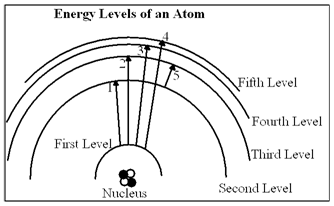How do scientists estimate the age of the universe?
A) They look up the answer in a book or they Google it.
B) They measure the abundances of radioactive elements in meteorites, and use their half-lives to calculate the age of the meteorites, which are the oldest solids in the solar system.
C) They measure the speeds and distances of galaxies, and calculate the time it took for them to travel that distance (away from us).
D) They make a guess: no one really knows how old the universe is.
E) They measure how fast the Sun is losing energy, and how much energy it has left to lose.
C) They measure the speeds and distances of galaxies, and calculate the time it took for them to travel that distance (away from us).
You might also like to view...
In the diagram, which of the transitions would absorb a photon with the smallest energy (longest wavelength)?

a. Transition 1
b. Transition 2
c. Transition 3
d. Transition 4
e. Transition 5
The ____________________ of Earth is composed of rocks at high density that behave as a plastic
Fill in the blank(s) with correct word
The 1964 experiment that checked the validity of the principle of the constancy of lightspeed involved
A) a NASA satellite that emitted radiation both forward and backward. B) jet planes carrying a highly accurate atomic clock, and a similar clock on Earth. C) a fast-moving sub-atomic particle that emitted radiation both forward and backward. D) the emission of light from two atoms that were at rest on Earth. E) comparison of the speeds of two parallel light beams, one emitted on Earth and other emitted from a jet airplane.
The sum total of all the wave energy in the oceans could supply all the world's energy needs
What will be an ideal response?